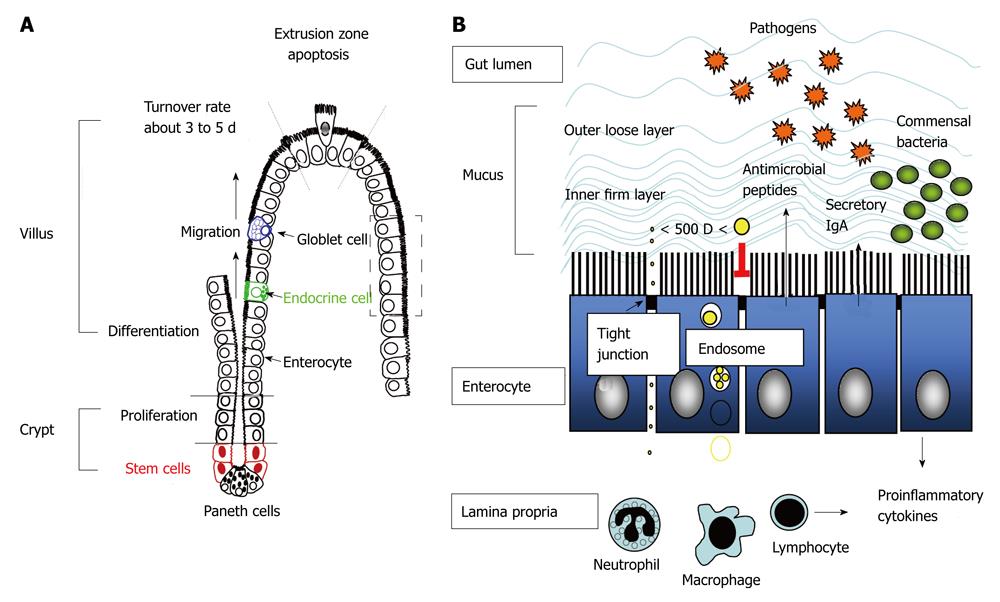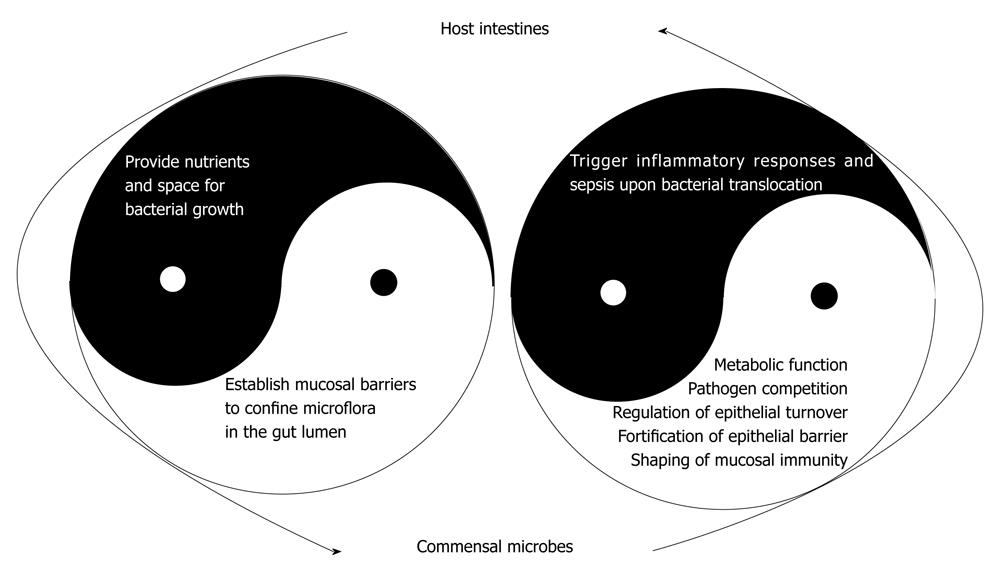Copyright
©2012 Baishideng Publishing Group Co.
World J Gastrointest Pathophysiol. Feb 15, 2012; 3(1): 27-43
Published online Feb 15, 2012. doi: 10.4291/wjgp.v3.i1.27
Published online Feb 15, 2012. doi: 10.4291/wjgp.v3.i1.27
Figure 1 Intestinal crypt-villus axis and formation of intestinal barriers for luminal confinement of commensal bacteria.
A: Stem cells in the crypt regions undergo proliferation and differentiation into columnar epithelial cells (enterocytes) with high expression of brush border enzymes and transporters, and concurrently migrate upward to the apex of the villi where cell apoptosis and shedding occurs at the so-called “extrusion zone”. The stem cells also differentiate into Paneth cells that migrate downward to the crypt bottom, as well as into mucin-secreting goblet cells and enteroendocrine cells that migrate upwards to the villous tips. During the differentiation and migration process, tight junctional proteins are formed at the cell-cell contact sites to seal off gaps between enterocytes; B: Enteric microbes are restricted in the gut lumen by physical barriers composed of epithelium and mucus, chemical barriers with antimicrobial peptides, and immune barriers such as secretory immunoglobulin A (IgA). The tight junctional complexes between plasma membranes of two cells exclude the influx of bacteria and molecules larger than 500 dalton through paracellular routes, whereas endosomal degradation limits transcellular transport of particles and proteins. If the epithelial barrier is breached and invasion of bacteria occurs, the underlying immune cells in the lamina propria such as phagocytes (macrophages and neutrophils) and lymphocytes are responsible for antimicrobial and inflammatory responses.
Figure 2 Dynamic interactions between host intestine and commensal microbes to achieve balance for maintenance of gut homeostasis.
The survival and growth of enteric microbes relies on energy supply from food nutrients, and are dependent on the space and anchor provided by the host intestines. Conversely, luminal microbes are capable of fermenting non-digestible dietary substances, generating short chain fatty acids and essential vitamins, and providing caloric sources for the host. These symbiotic bacteria also play important roles in pathogen competition, regulation of the turnover rate of enterocytes and fortification of epithelial barrier functions, as well as shaping of the mucosal immunity. From the host's point of view, tight physical, chemical and immune barriers of intestines are pivotal in the keeping of the number and location of the microfloral population in check in order to maintain the health-promoting effects, and to prevent bacterial dissemination and the triggering of local and systemic inflammatory responses. The balance of Yin-Yang between the host intestine and commensal microbes is central to maintaining homeostasis.
- Citation: Yu LCH, Wang JT, Wei SC, Ni YH. Host-microbial interactions and regulation of intestinal epithelial barrier function: From physiology to pathology. World J Gastrointest Pathophysiol 2012; 3(1): 27-43
- URL: https://www.wjgnet.com/2150-5330/full/v3/i1/27.htm
- DOI: https://dx.doi.org/10.4291/wjgp.v3.i1.27










